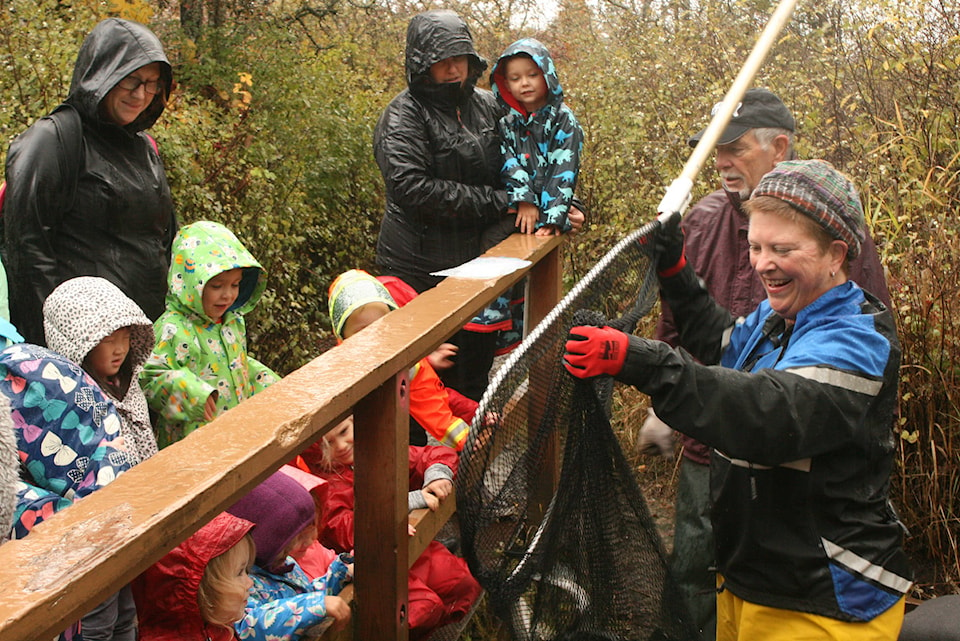Barring a miracle, officials are saying the number of returning salmon to South Island spawning grounds will be ‘a disaster’ for 2017.
Numbers are down to 300 in the Colquitz River, 16 coho and chinook in Goldstream, to about 150 coho up at Fanny Bay’s Rosewall Creek. It’s possible the heavy rains, which have flooded and muddied the rivers, could be hiding hundreds, maybe thousands of fish in the many South Island spawning grounds. But it’s unlikely.
And the implications are even worse, says Gary Caton of the Esquimalt Anglers.
Related: Colquitz counts 1,100 fish, less than expected in 2016
“It’s doom and gloom,” said Caton, looking ahead to the typical coho three-year spawning cycle. “This reflects on the 2020 returns.”
Goldstream has been hit the worst, with just 12 cohos and two chinooks to date. Colquitz’s 302 is mostly coho but compared to 1,100 at this time last year, it’s not good. Same goes at Craigflower, where Caton reports 425 fish, mostly coho, but had reason to expect as much as 1,500 to 2,000.
In Craigflower and Colquitz the number of jacks, or two-year-old coho, is high relative to the number of adults. Both had nearly 200.
“Nature sends the jacks in early to [help increase the spawn] and it can indicate a good year next year,” Caton said.
Coho are known to trickle in as late as January but even with the high waters and muddied rivers, it’s worrisome, said Judy Ackinclose, president of both the Goldstream Hatchery and Fanny Bay Enhancement project (Rosewall Creek).
“At this point we’ve had such torrential downpours, it’s been such a flood you can’t see anything,” Ackinclose said. “To get the stream keepers in the river for counts is non-existent, the river is high and it’s running chocolate, you can’t see any fish.”
The hope is once the rains abate, the rivers will reveal heavier than normal counts of fish, and carcasses.
What’s disheartening in the Goldstream River is the aggressive commercial fishery, with gill nets in the Satellite Channel approach waters of Saanich Inlet, said biologist Peter McCully, a director with the Goldstream hatchery.
“It’s a wall of nets out there, plus an unregulated tribal fishery at the mouth of the river,” McCully said. “Federal fisheries knows about it. I don’t blame the fisherman, they’re making a living, I blame the way our fisheries are managed. That’s a personal opinion.”
The Goldstream school aquarium project is at threat, as the hatchery is low on eggs to offer up for the program where elementary school kids nurture the eggs before delivering them back into the nursing grounds.
For decades Goldstream has relied on the lesser known but highly successful Mill Bay and District Conservation Society salmonid project in the Shawnigan watershed. Since the early 1980s the man-made run has counted up to 3,000 returning salmon for two out of three years. It thereby provided Goldstream with brood stock to keep Goldstream healthy.
This year is Shawnigan’s down year, and it has 181 coho (and counting, but it’s mostly done). It’s actually an increase for the unique run, said one of its directors, Ken Gray.
“It took years to get it off the ground and once it took it was two years good, one year bad, and the 181 is actually an increase,” Gray said. “However, we don’t have a lot to offer Goldstream for reintroduction. We’ve got a few saved for them.”
The South Island chum run is down too, but not to the dire extent as the coho and chinook. Much of the chinook population on the Southeast side of the island has been decimated in recent years, Gray said, mostly by fishing.
It’s believed the gill nets and seine nets in Satellite Channel are also affecting the Shawnigan numbers. Caton said this year’s Craigflower fish, which come up the Gorge Waterway, show evidence that it was also a rough year at sea.
“It’s a variation of factors, you never know exactly, but it’s not looking good,” Caton said.
Chum and coho will continue to trickle in but most of the above spawning grounds expect just a few fish a week.
reporter@saanichnews.com



